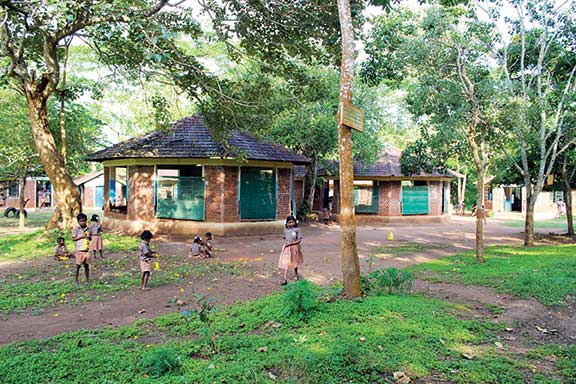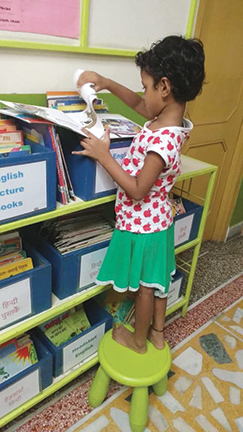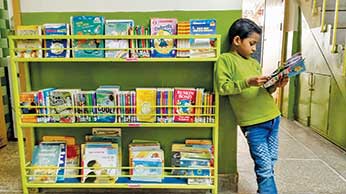Creating welcoming and safe learning spaces for children
Lakshmi Karunakaran
Fear grips the society that we live in. It has been embedded in almost everything we do. It controls what we should wear, what we should eat, who we should trust, who our children should talk to, who we should support, who we should vote for and so on. The traditional education system is probably one of the first formal learning spaces that a child encounters and it lays the foundation of this fear.
The education system itself lives in fear that trickles down from administrators, to educators, to students. The culture in schools has traditionally been associated with the culture of fear – the fear of breaking rules, the fear of teachers, the fear of asking questions, the fear of punishment, the fear of being caught on the wrong foot, the fear of being bullied, the fear of neglect, the fear of failing. Fear blinds us, it dissuades us from finding long-term solutions and encourages us to find short-term fixes. Fear has created a high degree of anxiety and dependency among our children and set them on a path of subservience, in most cases effectively killing their own unique abilities and any possibility of growth. Many of them struggle to cope with it even through their adult life, making a lasting impact on their mental health. Amandeep Sandhu, writer and novelist says, “I wrote Roll of Honour on my school experiences to get past the feeling of fear that I had inculcated as an adolescent through bullying and corporal punishment. It took me about seven years to write the book during which I battled my own depression and tried to find my voice to tell my story.” Sandhu studied in a military school in Punjab during the times of militancy and his book gives insights into his schooling experiences.
When ‘teaching discipline’ becomes irrevocably tied to punitive punishment and propagating fear, the school narrows its own definition and investment in the very individual it claims to benefit. Krishna Haresh, an educator in his presentation at a conference at Centre for Learning (CFL)1, Bangalore said, “I truly hope we all will feel that our responsibility is towards the individual learner and her inner and outer world. Our responsibility is towards creating a safer world ahead. I don’t see how we can justify coercion and castigation, instilling fear through painful punishments, disciplining through punitive regimentation and the like, all in the name of effective schooling! I am sure it is effective, but that is not the effect I hope you want to have. Our abiding, long-term interest has to be the welfare of a learner even though fear may seem like an effective short-term motivator.”

Beyond the culture of fear
How then do we go beyond this culture of fear? One of the first steps is to relook the definition of schools and learning spaces. Haresh says, “School is a place where students begin to learn about friendship, life, love, sex, death and other important experiences to come. A school’s curriculum cannot side-step learning about the learner, just as a teacher cannot teach without learning about the teacher. Every individual has a world within to unravel: a landscape of emotions that intricately weave themselves into our understanding and response to the world around. Can we observe this world carefully? We need to closely observe how fear paralyses and distorts relationships (for the student and for the adult) towards learning, towards the teacher, towards oneself, towards each other on a daily basis.”

Access to spaces
Sandhu says, “My school – housed in the Palace of Kapurthala, built by Maharaja Jagatjit Singh, on the lines of the French Palace of Fontainebleau, albeit smaller in scale – was a cynosure for tourists, heritage lovers, and of course us students and staff. It welcomed not only us but the world to Punjab. Yet, inside, the strict school regimen that fancied itself as a nursery for the armed forces, based on the idea of ‘discipline and punish’, the rituals of corporal punishment were brutal and scarred my growing up years. I encountered more barricades, in the name of discipline and correction, than open doors. I wonder if the building were any lesser, perhaps the school would not have been so full of itself and been kinder?”
It is important to think about who the learning space caters to, and how you are welcoming them into this space. How would you design your space in ways that the space reaches out to them? A space is after all more than four walls and a roof – it is an environment that speaks to anyone who enters it, telling them how they can fit into it and use it. How do we organize such a space and include elements within it that tell all those who enter that they belong, and that they can participate in happy, productive ways – by reading, playing, interacting, learning?
An invitation to read
Mridula Koshy, who runs a series of libraries in the National Capital Region (NCR) through the The Community Library Project (TCLP) says, “Our mission is to increase people’s access to books. For the majority of people in India there is no access to a book beyond the slim reader/textbook handed to the child in school. We know that putting books in a room and calling it a library does not result in true access. When people have been denied access for generations because of caste or class, there is a historic weight people are carrying, a weight which prevents them from walking into the library. They may not know what the space is, what it’s for, or even more likely they may know of it but believe that they are not welcome. A genuine welcome is a first best practice in ensuring that we build access for all.”
Koshy and her team spend hours walking through the communities that they work with to meet its people door to door to talk to them about the library program and invite them to visit it. They have equally put in efforts to make sure that the space itself becomes accessible to who it primarily caters to – the children of the community. “Our libraries are small jewels. We believe a beautiful space and an excellent, relevant and richly varied collection are evidence to our members of their value as readers. We have always rejected the idea that our library is a poor library for poor people. It is instead an excellent library for all people. We locate our libraries in working class neighbourhoods and the result is that the majority of our membership is working class and migrant,” adds Koshy.
However, in many schools the list of restrictions is far more than the list of accesses. Bhavini Pant, an educator from Bangalore recounts a simple step a librarian of a small school she visited in Tamil Nadu took to provide access to the library. The librarian announced that anyone can walk into the library at any time, not only during the library period. When Bhavini asked her the rationale behind this, she said, “I am part of a mainstream school that is oriented towards academics, I know that the library period will be the first to be sacrificed for a science or a mathematics class. In fact after middle school, our school doesn’t even have a library period. But I don’t want the children to stop reading because of this. I want them to feel that the library is always open to them.”
Making sure children have access to resources within a learning space is another critical aspect. In many learning spaces, everything is kept under lock and key, which already builds a culture of mistrust and hierarchy. “At the outset, in setting up our spaces we have consulted with and benefited from pro-bono support from a number of social architects and designers in Delhi. The single most important decision: open shelving that puts books at eye level and allows our readers to browse, pull out books independently, read the title, look at the pictures, read the blurb at the back and choose the book they wish to borrow,” says Koshy.
Letting the outside in
Many years ago I visited the Viveka Tribal Centre for Learning, a non-formal residential school in Hossahalli, Mysore. I was fascinated by its architecture, how it brought in openness through its architecture. Most classrooms, designed like gazebos had very little wall space that gave the feeling of being a part of the natural beauty of the school located near a forest land. Children walked in through any door/window into the classroom. I remember the school teacher explaining that this is an integral part of the philosophy of the school – openness. Also given that the school caters to children largely from the tribal areas, it is important that ‘education’ does not uproot them from nature and their traditional learning methods.

Freedom to think, question and dream
Access in this context can not only be defined in terms of physical spaces, but also to mental and emotional spaces. How can we create a space that is open to think and question? Sidbay recounts, “For me, it (a safe space) is an environment where a person is free to dream – to dream beyond the life they have led, to dream to break the cycle of poverty and discrimination. I was five when the civil war broke out in Sierra Leone, and even when no place truly felt safe, school was the safest place to be.” A safe space is created when the most marginalized in your school/learning space feels empowered to think, reflect, learn from mistakes and dream.
What is the role of educators themselves in creating such spaces? Rupa Suresh, educator, said at a conference held at Center for Learning in Bangalore, “Openness in relationship between the adult and the student seems most important. It is the first step if we want to create a learning environment for children. This relationship needs to be caring, there must be affection and we need to be interested in children’s lives. If there is no care, then I wonder on what ground the children will relate to adults. When children feel secure in their relationship with adults, it feels like they will engage with us, and with learning, more deeply. We notice in our experience, that most often children cooperate cheerfully when they trust adults and feel secure.”
Maybe a good place to start is – to be real. Show them that you are not only a teacher, but also a learner. That as you enter into a class you are entering into a space of mutual learning. Suresh elaborates, “As a teacher, I may be afraid of questions in class. When children ask questions and I don’t have an appropriate answer, I may get annoyed with the child for having raised the question. Here at CFL, we try to acknowledge that we don’t know and that we can find out together. Yes, we do feel bad but the clue seems to be to observe the feelings that are coming up in us and see the futility of the fear we experience. I have seen that children do respond well to this and it somehow also feels reassuring to them, I think, when they see adults also struggle with things just as they do. Fear may drive teachers to be authoritative, bring order and get work done. The language we use, our body language, may reflect this authority. If I am able to see, recognize that it is fear that is driving me to act, this can be the first step. Dialogue plays a significant role in our work at CFL: dialogue amongst us teachers, between students and teachers, and with parents too. In these sessions, we spend considerable time and energy investigating our psychological worlds. These conversations need not be conclusive or prescriptive. All experiences are subject to inquiry, including the emotion of fear.”
While working with children in schools and community spaces, I realize that most of my generation of educators grew up imbibing the diktats of closed environments. The challenge for us is to now find the courage to turn around such spaces and open them up. Even if we missed them, let the next generation reap the benefits of safe spaces, dream and flourish.
References:
1. https://cfl.in/wp-content/uploads/2016/06/Conference-Proceedings-web.pdf
2. https://www.globalpartnership.org/blog/creating-safe-learning-spaces-all-children-and-youth
The author is an arts based educator from Bangalore. She can be reached at lakshmikarunakaran@gmail.com.
